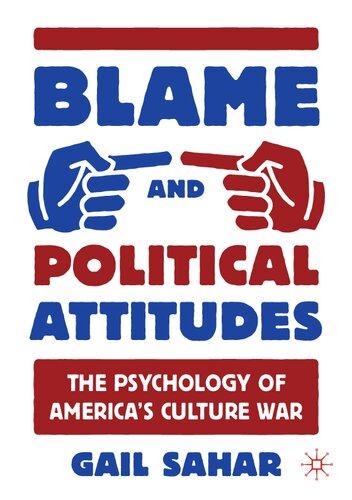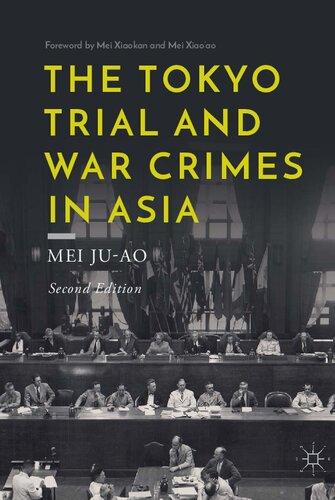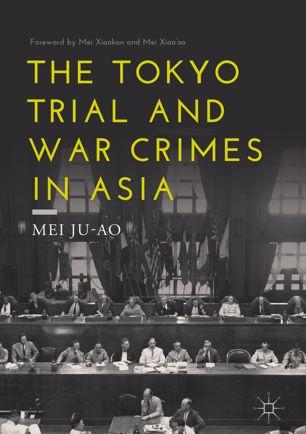War Crimes: Causes, Excuses, And Blame Matthew Talbert
Visit to download the full and correct content document: https://ebookmass.com/product/war-crimes-causes-excuses-and-blame-matthew-talb ert/

More products digital (pdf, epub, mobi) instant download maybe you interests ...

Blame and Political Attitudes: The Psychology of America's Culture War Gail Sahar
https://ebookmass.com/product/blame-and-political-attitudes-thepsychology-of-americas-culture-war-gail-sahar/

The Tokyo Trial and War Crimes in Asia 2nd Edition Mei Ju-Ao
https://ebookmass.com/product/the-tokyo-trial-and-war-crimes-inasia-2nd-edition-mei-ju-ao/

Sparta and the Commemoration of War Matthew A. Sears
https://ebookmass.com/product/sparta-and-the-commemoration-ofwar-matthew-a-sears/

The Tokyo Trial and War Crimes in Asia 1st ed. Edition Mei Ju-Ao
https://ebookmass.com/product/the-tokyo-trial-and-war-crimes-inasia-1st-ed-edition-mei-ju-ao/

Monarchies and the Great War 1st ed. Edition Matthew Glencross
https://ebookmass.com/product/monarchies-and-the-great-war-1sted-edition-matthew-glencross/

Human Nature and the Causes of War 1st ed. 2018 Edition
John David Orme
https://ebookmass.com/product/human-nature-and-the-causes-ofwar-1st-ed-2018-edition-john-david-orme/

Additional Mathematics - Pure and Appl. 6th ed. Edition
J. Talbert
https://ebookmass.com/product/additional-mathematics-pure-andappl-6th-ed-edition-j-talbert/

Heinous Crimes Cm Wondrak
https://ebookmass.com/product/heinous-crimes-cm-wondrak/

Blame It on the Mistletoe Beth Garrod
https://ebookmass.com/product/blame-it-on-the-mistletoe-bethgarrod-3/

War Crimes
War Crimes
Causes, Excuses, and Blame
Matthew Talbert and Jessica Wolfendale
Oxford University Press is a department of the University of Oxford. It furthers the University’s objective of excellence in research, scholarship, and education by publishing worldwide. Oxford is a registered trade mark of Oxford University Press in the UK and certain other countries.
Published in the United States of America by Oxford University Press 198 Madison Avenue, New York, NY 10016, United States of America.
© Oxford University Press 2019
All rights reserved. No part of this publication may be reproduced, stored in a retrieval system, or transmitted, in any form or by any means, without the prior permission in writing of Oxford University Press, or as expressly permitted by law, by license, or under terms agreed with the appropriate reproduction rights organization. Inquiries concerning reproduction outside the scope of the above should be sent to the Rights Department, Oxford University Press, at the address above.
You must not circulate this work in any other form and you must impose this same condition on any acquirer.
Library of Congress Cataloging-in-Publication Data
Names: Talbert, Matthew, author.
Title: War crimes : causes, excuses, and blame / Matthew Talbert & Jessica Wolfendale.
Description: New York : Oxford University Press, 2019. | Includes bibliographical references and index.
Identifiers: LCCN 2018008363 (print) | LCCN 2018034386 (ebook) | ISBN 9780190675882 (updf) | ISBN 9780190675899 (epub) | ISBN 9780190675905 (online content) | ISBN 9780190675875 (cloth : alk. paper)
Subjects: LCSH: War and crime. | War crimes.
Classification: LCC HV6189 (ebook) | LCC HV6189 .T35 2018 (print) | DDC 364.1/38—dc23
LC record available at https://lccn.loc.gov/2018008363
9 8 7 6 5 4 3 2 1
Printed by Sheridan Books, Inc., United States of America
This book is dedicated to our mentors and friends, John Martin Fischer, Jeanette Kennett, and Gary Watson.
Acknowledgments xi A Note on Authorship xiii
Introduction 1
1. What are war crimes? 2
2. Outline 3
CHAPTER 1 Explaining Behavior: The Person or the Situation? 9
1. The situationist experimental tradition 11
1.1 Solomon Asch 11
1.2 Stanley Milgram 12
1.3 John Darley and Daniel Batson 14
2. Philosophical situationism 16
3. Responses to philosophical situationism 19
4. The principle of construal 22
5. Conclusion 24
CHAPTER 2 Situationism and War Crimes 25
1. Situationist accounts of war crimes 26
1.1 Paul Roth’s situationist explanation of the Holocaust 27
1.2 Philip Zimbardo’s situationism 30
1.3 John Doris and Dominic Murphy’s account 33
1.3.1 Situational pressures on the battlefield 35
1.3.2 Distal pressures 37
1.3.3 Distal pressures, military training, and military culture 38
1.3.3.A Obedience to authority and learning to kill 38
1.3.3.B Group bonding 41
1.3.3.C Ideology 41
2. Applying the situationist account 42
2.1 My Lai 43
2.2 Abu Ghraib 44
2.3 Haditha 45
3. Conclusion 46
CHAPTER 3 A Dispositional Account of War Crimes 49
1. What’s wrong with the situationist account? 51
2. A dispositional account of war crimes 53
2.1 Morality as socially articulated 55
2.2 The creation of war crimes: ideology and social narratives 59
2.3 CAPS theory: understanding individual perpetrators 60
2.4 Character traits in CAPS theory 61
2.5 Comparing CAPS and situationism 63
2.6 Explaining perpetrator behavior 65
3. Conclusion 67
CHAPTER 4 Excusing Perpetrators 69
1. What is moral responsibility? 71
2. Situationism and moral responsibility 73
3. Normative competence and moral responsibility 75
4. Normative competence and war crimes 77
5. Circumstantial and constitutive moral luck 81
6. Conclusion 87
CHAPTER 5 Blaming Perpetrators 89
1. Excuses 91
2. Ignorance as an excuse for war crimes 92
3. War crimes and moral justifications 94
4. War crimes and exemptions 98
5. Ill will and excuses 101
6. Moral luck 103
7. The victim’s perspective 105
8. Conclusion 109
CHAPTER 6 Hard Cases 111
1. Child soldiers 112
1.1 International law and policy 112
1.2 Characteristics of the child soldier 113
1.3 The passive victim model 115
1.4 Child soldiers’ capacity for agency and moral responsibility 117
1.5 Concluding thoughts on child soldiers 122
2. Causally complex cases 124
2.1 Remote weaponry 124
2.2 Causal contributions and outcomes 128
2.3 Kutz’s account of responsibility and collective action 129
2.4 The Dresden case 130
2.5 The supply chain 134
3. Conclusion 136
CHAPTER 7 Punishing and Preventing War Crimes 139
1. The superior orders defense 140
1.1 The duress interpretation 142
1.2 The “reasonable mistake” interpretation 143
1.3 The motive argument 146
2. Preventing war crimes 149
2.1 Current approaches to military ethics training 149
2.2 A new approach to preventing war crimes 151
Bibliography 155
Index 165
ACKNOWLEDGMENTS
This book could not have been written without the support and help of many people over the last five years. First and foremost, we would like to thank The Character Project at Wake Forest University and the John Templeton Foundation for the support of a grant that allowed us to conduct essential research for this book. In addition, we would like to thank John Doris; Nancy Snow; Mitt Regan; and, in particular, Christian Miller for their continued support and helpful feedback during the writing of this book. We would also like to thank the audiences at several conferences and colloquia where we presented material that was incorporated into this book. Finally, we are grateful to two anonymous referees for Oxford University Press who provided suggestions and comments that greatly improved the final version of this book, and for the support and guidance of Peter Ohlin at Oxford University Press.
Portions of Chapters 3, 4, and 5 were previously published in Talbert & Wolfendale, “War Crimes: Causes, Excuses, and Blame,” C. Miller, R. Furr, A. Knobel, and W. Fleeson, eds., Character: New Directions from Philosophy, Psychology, and Theology (Oxford, UK: Oxford University Press, 2015), 671–692. Portions of Chapters 3 and 7 were previously published in Wolfendale, “War Crimes and Military Culture,” in G. R. Lucas, Jr., ed., The Routledge Handbook of Military Ethics (Abingdon, UK: Routledge, 2015), 82–96.
A NOTE ON AUTHORSHIP
Theorder of the authors’ names on the title page is alphabetical; each contributed equally to the production of this book. Matthew Talbert was primarily responsible for initial drafts of Chapters 1, 4, 5, and 6. Jessica Wolfendale was primarily responsible for initial drafts of the Introduction and Chapters 2, 3, and 7. The authors worked together closely to produce final versions of all chapters.
War Crimes
Introduction
In the Iraqi town of Haditha in 2005, US Marines killed 24 Iraqi civilians, including women and children. Charges against six Marines were dropped and a seventh was acquitted. How should we assess this and similar incidents? On the one hand, punishing the Marines might be unreasonable since they were subject to extreme situational pressures leading up to the massacre, including combat stress, exposure to constant attacks, and the loss of one of their own. On the other hand, perhaps they should be held responsible for their actions, since they intentionally killed civilians. This case illustrates one of the most important questions at the intersection of theories of moral responsibility and international law: Are military personnel1 who commit war crimes culpable for their actions? Or should they be excused because of the situational pressures under which they act?
In this book we take up these questions, and propose a theory of the causes of war crimes and the responsibility of war crimes perpetrators. In the first half of the book, we argue that accounts of war crimes that attribute the causes of war crimes to the external situational pressures to which military personnel are subject are mistaken. We develop an alternative dispositional theory of the causes of war crimes in which combatants’ agency and dispositions play a crucial role in explaining how they can become perpetrators of war crimes. Understanding the causes of war crimes requires understanding how ordinary combatants can come to see acts of torture, rape, and killing as compatible with, and even required by, important moral and military values. In many cases, war crimes occur not because military personnel are overwhelmed by fear or anger but because
1 Throughout this book, we use “military personnel” and “combatant” rather than “soldier” since this last term refers only to Army personnel. “Combatant” should be understood to mean all armed forces personnel, not just those actively engaged in combat.
the commission of war crimes makes sense to them, given the social construction of morality in which they operate and their own unique goals, self-conceptions, and values.
This raises the question of whether military personnel who commit war crimes are morally responsible for their actions, the topic of the second half of this book. Some theories of responsibility tend to excuse military personnel on the basis of situational pressures that in many cases lead perpetrators to sincerely believe that their actions are permissible. Such theories of responsibility are, we argue, unacceptably exculpating. In particular, these theories imply that victims of war crimes cannot reasonably blame their attackers. We argue that to require victims of war crimes to forego blame just because their attackers believed that their crimes were permissible fails to show sufficient regard for victims’ moral standing.
Drawing on the dispositional account of war crimes that we develop in the first half of this book, we argue in favor of a theory of responsibility that locates culpability in the attitudes displayed through an agent’s actions, regardless of how those attitudes were acquired. Many war crimes perpetrators act intentionally and voluntarily, so their actions express and communicate their attitudes and beliefs regarding their victim’s moral status. Respecting the victims of war crimes thus requires that we understand and acknowledge the basis of their feelings toward those who harm them intentionally. In the final section of the book, we consider the implications of our view for the punishment of war crimes perpetrators, and the prospects for preventing war crimes in the future. Our hope is that this book provides a framework for understanding war crimes that will generate further work on the prevention of war crimes.
1. What are war crimes?
The Rome Statute, which established the International Criminal Court (ICC), defines war crimes as “grave breaches of the Geneva Conventions” as well as other “serious violations of the laws and customs applicable in . . . armed conflict” (Rome Statute of the ICC 1998, Article 8). The laws and customs applicable in international and non-international armed conflicts are found in numerous treaties and conventions, such as the Geneva Conventions, which reflect decades of legal and philosophical debates about the moral constraints on war.2 While many acts may violate
2 See Gutman, Rieff, & Dworfman (2007) for a helpful summary of war crimes legislation and case studies.
the laws of armed conflict, according to the International Committee of the Red Cross, “violations are in practice treated as serious, and therefore as war crimes, if they endanger protected persons or objects or if they breach important values” (International Committee of the Red Cross 2017). Examples of violations that endanger protected persons include direct attacks on civilians or civilian property, and examples of violations that breach important values include acts such as “abusing dead bodies, subjecting persons to humiliating treatment . . . violation of the right to fair trial, and recruiting children under 15 years of age into the armed forces” (International Committee of the Red Cross 2017). The moral values breached by such conduct include familiar ideas of human dignity, the right to be free from torture, and the protection of the innocent.
Despite the volume of established international law on war crimes, we recognize that there are important and controversial questions about the definition of war crimes. For example, there is an ongoing debate about whether and under what conditions causing the deaths of civilians as collateral damage is morally permissible (Crawford 2013), and there is controversy about how categories such as “combatant” and “civilian” ought to be defined (McMahan 2009; Primoratz 2007). However, important as these questions are, it is not the purpose of this book to offer a theory of war crimes or to take a stance on these broader definitional issues. For our purposes, we accept the view that there are moral constraints on the use of force in war, including constraints on who may be targeted,3 and that these moral constraints justify legal constraints. In addition, the case studies that are the focus of this book are not controversial examples of war crimes: they are cases of torture, rape, genocide, and the direct and intentional killing of unarmed civilians.
2. Outline
Chapter 1 begins with a discussion of the relationship between the crimes committed by American troops at the Abu Ghraib prison in Iraq and Philip Zimbardo’s 1971 Stanford Prison Experiment (Haney, Banks, & Zimbardo 1973; Zimbardo 2008). Zimbardo’s experiment is one of the most famous of a large body of social psychology experiments that support the
3 Thus while there is disagreement about how to define the categories of “civilian” and “combatant,” there is broad consensus that there is an important moral (and legal) distinction between legitimate and illegitimate targets in war, however the lines may be drawn between them.
“situationist” perspective on human behavior; other important examples include Asch (1956), Milgram (1974), and Darley and Batson (1973). While there is no single unified situationist theory, a central situationist claim is that features of the situations in which people act have a greater influence on behavior than we ordinarily suppose, and enduring features of personality and character have a correspondingly smaller role in explaining behavior. We explain how this research has been interpreted by psychologists such as Lee Ross and Richard Nisbett (2011) and by philosophers such as Gilbert Harman (2009) and John Doris (2002). Harman and Doris have argued that the situationist data requires us to significantly revise our everyday notions of moral character, and the chapter concludes with our reflections on several objections that have been pressed against them by philosophers such as Julia Annas (2005), Rachana Kamtekar (2004), and Gopal Sreenivasan (2002).
In Chapter 2, we consider the application of the situationist view to war crimes. A number of the experiments discussed in Chapter 1, particularly those of Zimbardo and Milgram, focus on situations that seem directly relevant to the circumstances in which war crimes tend to occur. For this reason, several social psychologists and philosophers including John Doris and Dominic Murphy (2007), Philip Zimbardo (2004a, 2008), and Paul Roth (2004), argue that situationism offers the most plausible explanation of how and why war crimes occur. In particular, the situationist account seems to answer one of the most pressing questions raised by the study of war crimes: Why do so many perpetrators of war crimes appear to be ordinary people with no prior history of sadism or cruelty?
According to the situationist view, war crimes can occur as a result of both immediate battlefield conditions (such as extreme fatigue, fear, and stress) and the ongoing situational pressures of military training and culture, such as exposure to ideologies and desensitization to the infliction of suffering. Advocates of this view argue that this combination of situational forces can undermine the ability of military personnel to recognize and act on relevant moral considerations, leading them to believe that certain acts, such as torture, are permissible. Thus military personnel may be unable to recognize illegal and immoral orders, even in situations arising far from the heat of battle.
In Chapter 3 we challenge the situationist account of war crimes and offer an alternative dispositional account of the causes of war crimes. The situationist accounts of war crimes described in Chapter 2 are inadequate primarily because they cannot explain the variety of attitudes that perpetrators of war crimes display toward their crimes, or why
some individuals refuse to participate in war crimes. The dispositional account that we propose is sensitive to the insights afforded by the situationist experiments but emphasizes the ways in which war crimes can be conceived of as expressions of combatants’ character traits and moral agency. The conception of traits that we develop draws on a social cognitivist theory of personality according to which personality is best construed as a Cognitive-Affective Personality System (CAPS): a complex interaction between external situational factors and agents’ internal cognitive and affective processes (Mischel 1973; Mischel & Shoda 1998). We argue that military training and culture leads to the development of CAPS traits in military personnel by interacting with and shaping their goals, actions, beliefs, and emotions related to their military service.
In addition, we explain how perpetrators of war crimes can come to sincerely believe that their actions are permitted or even required by military values and moral principles. This process of moral legitimation involves the social articulation of morality (Pauer-Studer & Velleman 2011, 335): a process by which moral concepts are “filtered” through preexisting cultural and empirical beliefs in such a way that actions such as genocide can come to be viewed as compatible with these concepts.
In Chapter 4 we turn to the issue of perpetrators’ moral responsibility, and we consider various arguments for the conclusion that they often have access to excuses that allow them to avoid moral blame for their actions. For example, John Doris and Dominic Murphy (2007) argue that, as a result of the situational pressures to which they are subjected, it is often unreasonable to expect military personnel to accurately assess the moral status of their behavior. They conclude, therefore, that it is often unfair to blame perpetrators for their wrongdoing. Other philosophers (including Fricker 2010; Levy 2003; Rosen 2004; Wolf 1987) have developed related accounts of moral responsibility—though mostly without reference to situationism—that yield similar results if applied to war crimes. Concerns about moral luck might also suggest that perpetrators are not open to moral blame: if it is a matter of bad luck that military personnel are exposed to pressures that lead them to act as they do, then perhaps it is unfair to blame them for their actions. As with the argument based on the supposed difficulty that military personnel face in recognizing the moral status of their behavior, the argument from moral luck can be developed with or without reference to situationism. There are, then, arguments in favor of excusing perpetrators if one accepts either a situationist explanation of war crimes or the dispositional approach that we advocate in Chapter 3.
In Chapter 5 we explain why the arguments in the preceding chapter fail. On our view, an agent is blameworthy if her behavior manifests an inappropriate degree of moral regard for others. Typically, this involves treating others with unjustified contempt, ill will, or certain forms of indifference. We argue that a perpetrator’s actions may manifest these objectionable qualities regardless of whether he believes that he is acting permissibly, and regardless of whether he is at fault for possessing this belief. This claim is developed in the context of the dispositional account of war crimes presented in Chapter 3, which is particularly well suited to our account of moral responsibility since it stresses the role that agents’ beliefs, goals, and values play in their actions.
An important part of our argument in Chapter 5 involves distinguishing between two types of moral ignorance. Some forms of moral ignorance excuse a wrongdoer from blame. For example, if a person is blamelessly ignorant of the fact that her action will injure others (and her ignorance is not itself indicative of a failure of moral regard), then she is excused from blame for causing these injuries because she does not violate the basic moral demand of showing due regard for others. By contrast, many of the perpetrators discussed in Chapter 3 are aware of the negative consequences of their behavior; their moral ignorance is constituted by the fact that they wrongly believe that it is permissible to bring about these consequences. A torturer, for example, is aware that he physically harms his victims, but he may regard his behavior as permissible and his victims as morally open to this treatment. We argue that this form of ignorance is compatible with blameworthiness since it is compatible with expressions of contempt, ill will, or indifference. Thus, the arguments in Chapter 4 are defective to the degree that they introduce this latter type of moral ignorance as an excusing condition. In addition, we argue that concerns about this type of moral ignorance, and about moral luck, do not give us reason to think it is unfair to blame perpetrators because, from the victim’s perspective, these things do not change the interpersonal moral quality of a perpetrator’s behavior. Indeed, we argue that to view perpetrators as inapt targets for blaming responses often fails to take appropriate account of the ways that they have wronged their victims.
In Chapter 6 we apply the theory of responsibility and blameworthiness developed in Chapter 5 to difficult cases that may prove problematic for our approach. We begin with a discussion of child soldiers. Intuitively, the typical child soldier is not morally responsible for his behavior, yet child soldiers seem capable of possessing morally objectionable attitudes and expressing them through their actions. Thus, child soldiers may often turn
out to be blameworthy on our account. This result may seem counterintuitive, but we believe that this position is justified (at least in many cases) by the development of a more detailed and accurate picture of the child soldier than is usually entertained by the general public. In the second half of the chapter we focus on various causally complex cases. These cases include instances in which perpetrators are at a significant physical distance from those they harm, cases involving harm caused by actors in hierarchical institutions, and scenarios in which individual wrongdoers make marginal contributions to collective efforts. These cases raise concerns about when a perpetrator can be said to have the attitudes that license blame, as well as more general questions about the role that an agent’s causal contribution to an outcome should play in our assessment of his moral responsibility.
Chapter 7 turns to the question of the punishment and prevention of war crimes. While the bases of legal liability for participation in war crimes are complex and controversial, and examining this topic in detail is beyond the scope of this book, we show how our account of responsibility has important implications for a particularly controversial defense against a charge of war crimes: the superior orders defense. While few now defend the view that superior orders provide a complete defense against a charge of war crimes, there is little agreement about the degree to which acting under orders affects a combatant’s blameworthiness or the severity of punishment they deserve. This has resulted in inconsistent applications of the defense, sometimes even within the same court (Bohrer 2012, 17). We consider a number of different arguments for the view that a combatant who commits a war crime under orders is less blameworthy (and warrants less severe punishment) than one who commits such a crime maliciously, and argue that the only defensible conception of the superior orders defense is one in which a combatant acting under orders can plead duress or coercion.
The second part of Chapter 7 turns to the question of preventing war crimes. While legal punishment is a crucial tool in the fight against war crimes, developing strategies for preventing war crimes is equally important. We show how the account of war crimes that we develop in this book offers important insights into prevention strategies that, we hope, can provide the basis for further work on this important topic.
